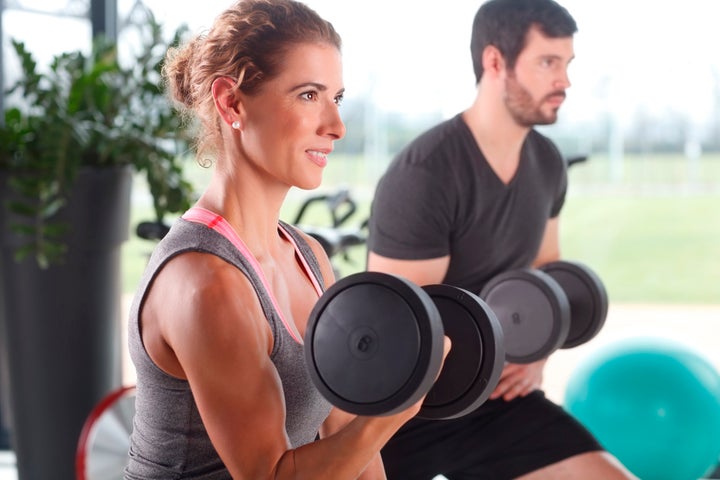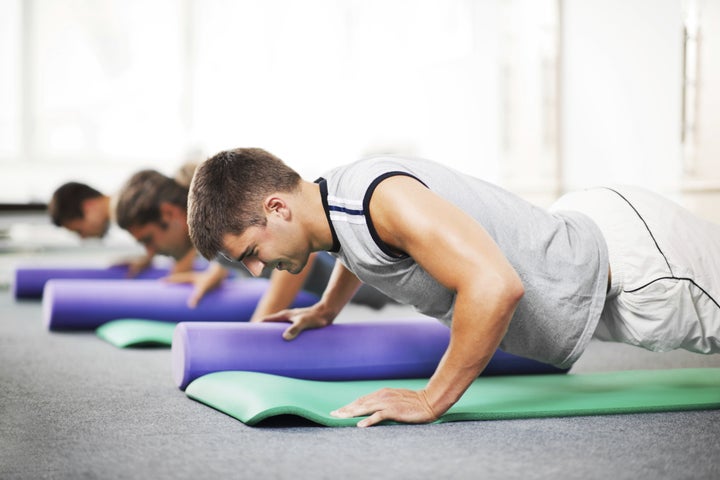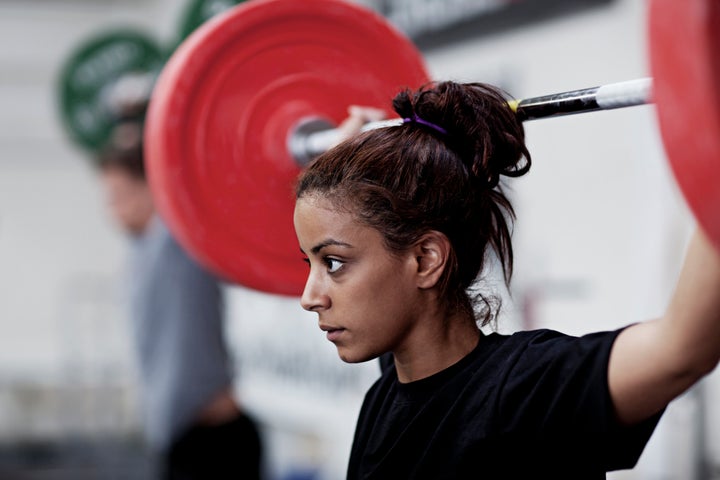You only have to look at the free weights area of your average gym, or pop your head round the door at a yoga or Pilates class (not to mention Zumba), to see that gender divide is still going strong in the world of fitness. Women and men still, on the whole, train differently.
According to data from survey company Gymetrix, while use of cardio machines is evenly distributed between the sexes, only 7% of those on free weights at any given time are female. Out of approximately 8,000 women surveyed, just 3% named dumbbells as one of their three favourite pieces of equipment.
But the workout landscape is changing (and not before time).

Time to change the rules
A new raft of personal trainers and fitness coaches are trying to get the message across that by sticking to these outdated gender constructs, we are doing our workouts all wrong and missing out on training goals.
Breaking news: men and women should train the same.
“Unless someone has some kind of gender-specific issue, there’s really no need for men and women to train differently. It’s more about making the training align with the goals of the individual,” says personal trainer Julia Buckley, founder of online gym juliabuckleyfitness.com.
From women reclaiming the free weights area and men signing up for Pilates to everyone curbing their cardio, these are the new gender-free workout rules.
Why men should join the class
Statistics show that men are in the majority on the gym floor – around 60-65%, according to Gymetrix. And one of the reasons they cite this is many women join the gym and only use the classes.
And while you might find a smattering of men in classes like yoga or body pump – in the large part, they tend to be in the minority. But men who see exercise classes as a woman’s domain could be missing a trick… and missing out on a six-pack.
The gender split in most Pilates classes suggests men see the discipline as a ‘woman thing’ – perhaps it’s all that talk of pelvic floor muscles. But Joseph Pilates (yep, a bloke) developed the technique to increase strength, flexibility and control of the body.
An increasing number of world-class rugby players and top footballers are turning to Pilates as a way of improving co-ordination, mobility and flexibility, as well as for preventing, and recovering from, injuries.
And the men’s media are behind it, too: GQ has explained Why Real Men Do Pilates (with illustrated step-by-step instructions), while Coach magazine shows readers How To Get A Six-Pack With Pilates.

Why women should lift weights ‘like a man’
It is a longstanding myth that a woman will ‘bulk up’ if she lifts weights that are too heavy – and lots of reps of lighter weights are the key to a toned, lean look.
“If a woman wants to build strength, she can certainly do the same strength training program as a man,” says Buckley. “Men generally gain muscle more easily than women because their bodies produce more testosterone, but the same training principles work for both sexes.”
The New Rules of Lifting For Women by Lou Schuler, Cassandra Forsythe and Alwyn Cosgrove, also refutes the misconception that women will bulk up if they lift heavy weights. Its training plan demands women “put down the ‘Barbie’ weights, step away from the treadmill, and begin a strength and conditioning regime for the natural athlete in every woman.”
Buckley adds that most people have the same goal these days, irrespective of gender.
“From what I see nowadays, the main aim of both sexes when they first start exercise will typically be to shed fat, but men are usually a bit more concerned with gaining muscle as well. That said, I’m seeing more and more women wanting the same. In fact, I’d say at this point, most women state their goals as wanting to get leaner and have muscle definition.
“For sure, men usually want bigger muscles than women, but that will happen anyway, all other things being equal, for a typical man and woman following the same training plan, “ she concludes.
Fitness coach and HuffPost blogger Melissa Edmunds agrees, and cites the use of light weights as the reason many women are not getting the definition they crave:
“We (especially women) are programmed to believe that we must stick to dumbbells less than 10 pounds and perform dozens of reps so that we can ‘tone’ our bodies and avoid getting big, ‘manly’ muscles.
“This whole myth of bulking up makes no sense. Think you’re getting big from lifting weights? Guess what, that’s fat you need to lose, not muscle.”

Men and women: curb the cardio
“Where a lot of people of both sexes often go wrong when getting slimmer is the main goal is they only do cardio exercise, like running, aerobics, cycling, Zumba, etc.,” says Buckley.
“Adding muscle to the body is hugely helpful in both burning fat and maintaining a lean physique because it is very metabolic tissue. The more muscle you have on your body, the more calories your body burns, when exercising and even when resting.”
Edmonds agrees that muscle mass is the key to staying toned:
“That ‘toned’ look you’re going after is achieved by increasing muscle mass and reducing body fat. You can do cardio all day every day and you’ll never achieve the look you want if you don’t have enough muscle underneath that fat layer that you’re working so hard lose.”
That’s not to say that cardio doesn’t have its place, of course, but running for hours on end at the same pace just isn’t an efficient way to burn fat.
“My recommendation is to start with a couple short HIIT sessions and make sure your diet is 100% in line before you start adding additional cardio,” says Edmonds. “The exact amount you should be doing varies by the individual. Get to know your body by playing around with your cardio length, intensity, method, and so forth, and see how it reacts.”